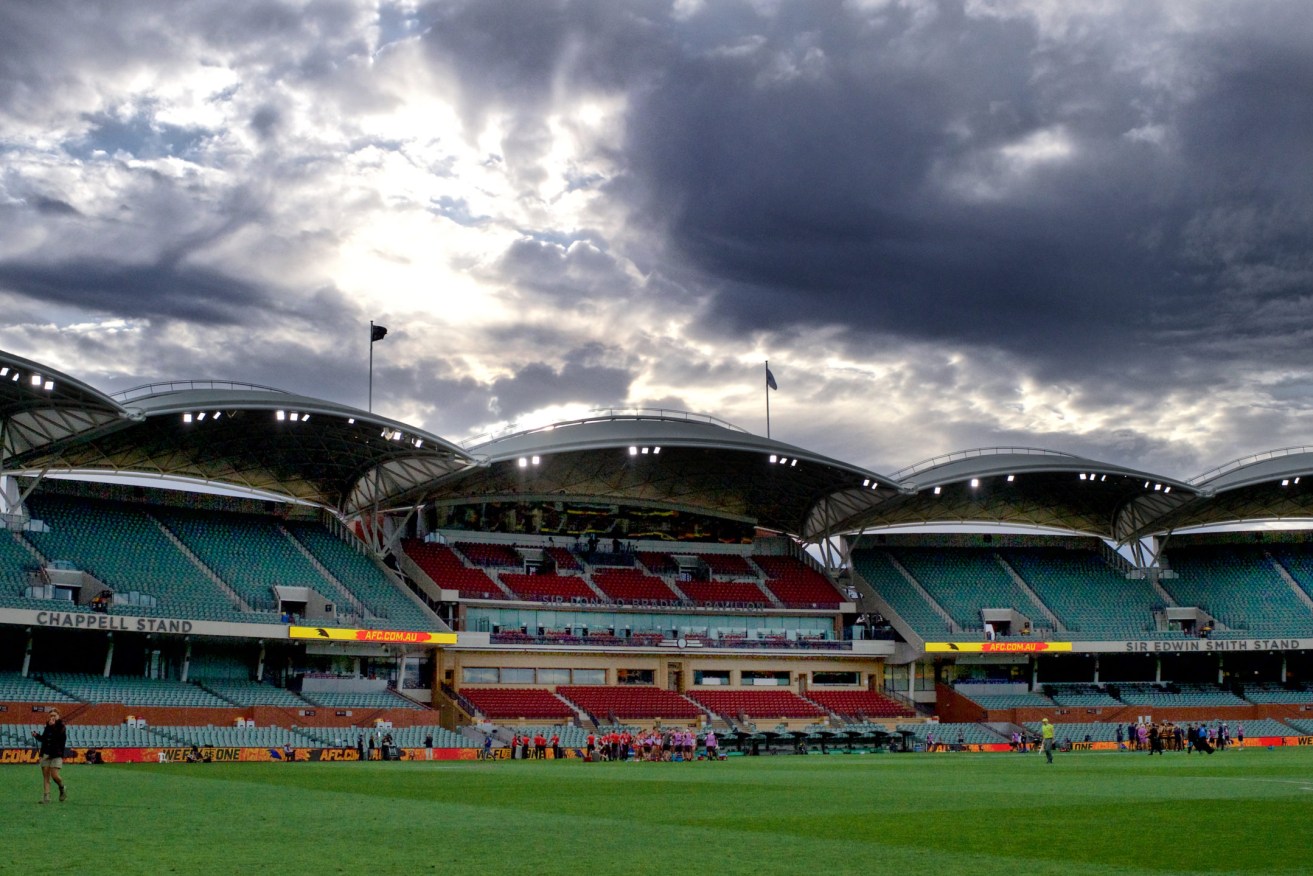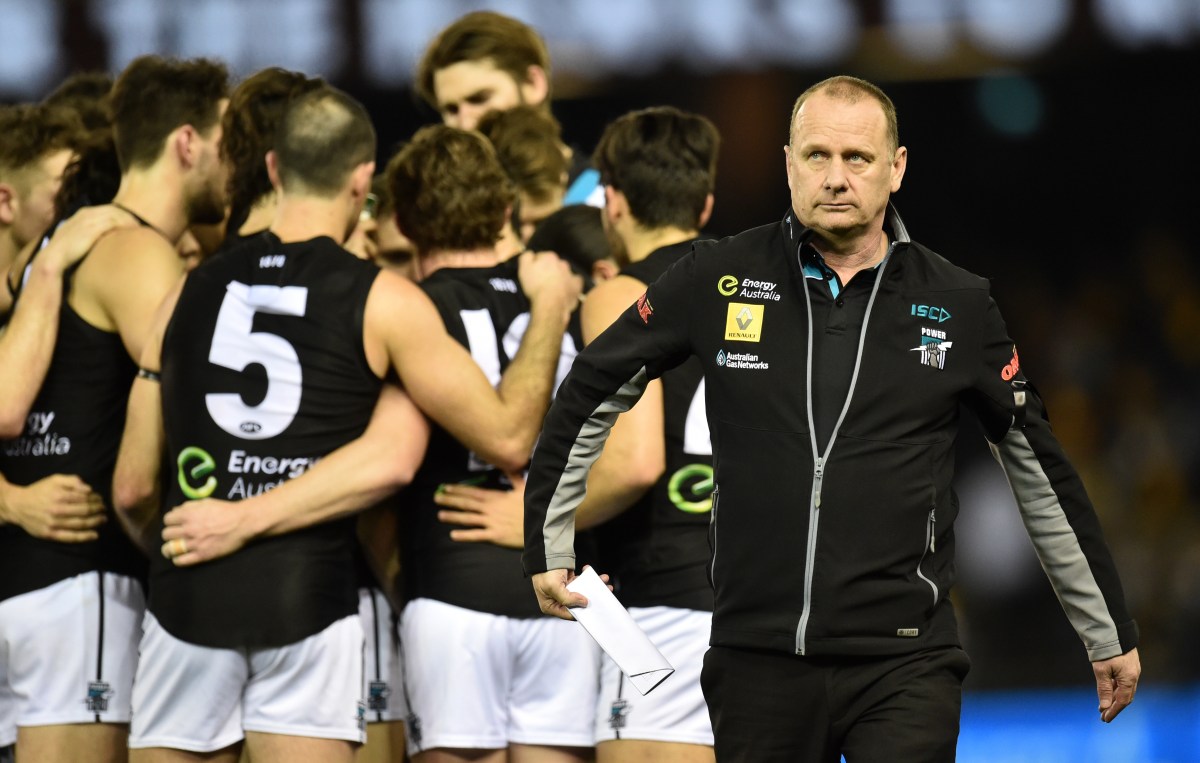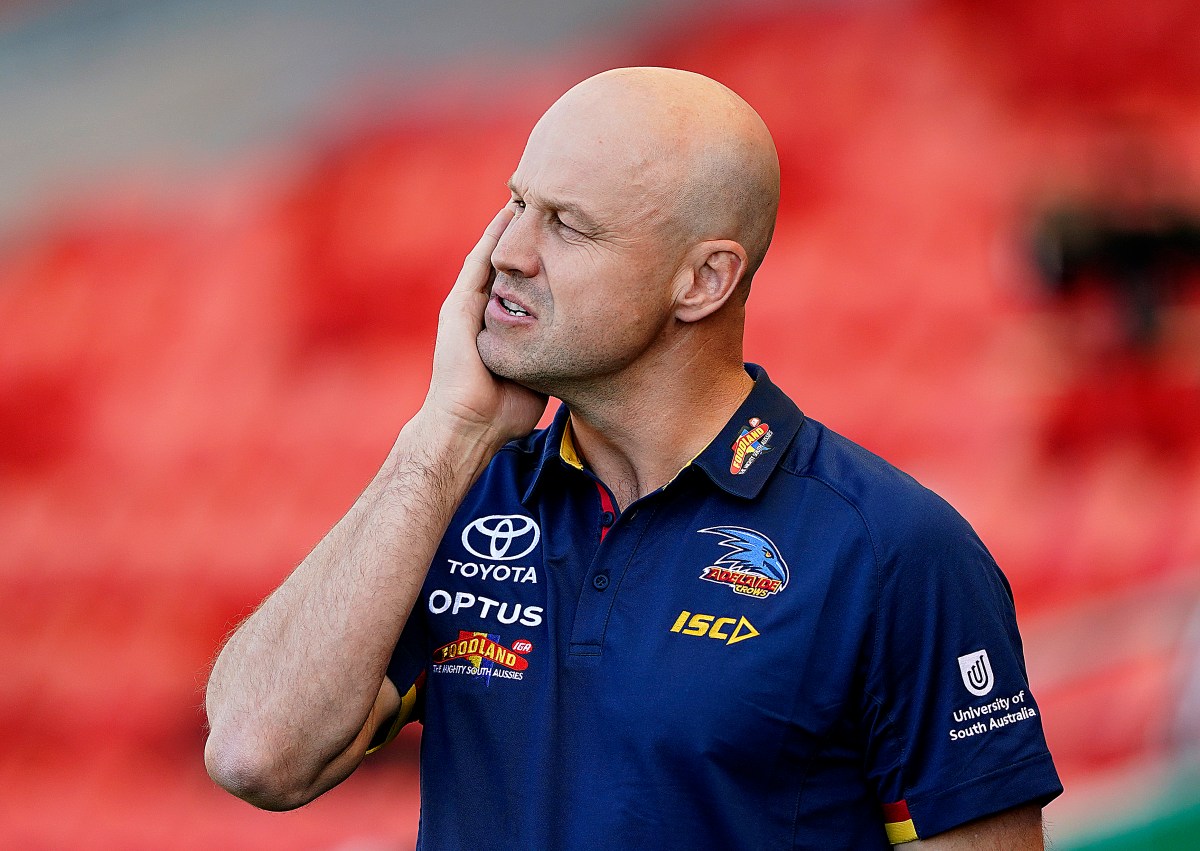Crows v Power in 2021: leaders and legends speak up
The AFL season opening next week will refocus the spotlight on the wooden-spoon Adelaide Football Club and rising cross-town rival Port Adelaide. Club leaders and legends talk frankly to Michelangelo Rucci about the high stakes for both teams this season.


Photo: Michael Errey/InDaily
Never before have the Adelaide and Port Adelaide football clubs been so far apart on the football field.
The tale of one city/two teams is very much about the best of times for the Power – and the worst for the Crows.
Port Adelaide ranked top of the AFL rankings at the end of last year’s home-and-away season. Adelaide was 18th and last for the first time in its 30-year story as South Australia’s first representative in the expanding national league.
During Port Adelaide’s darkest hour – the 2011-2012 nightmare when the Power ranked 16th of 17 with three wins in 2011 and lost on the first showing to each of the new AFL franchises of Gold Coast and Greater Western Sydney – the biggest rankings gap between the SA-based clubs became 12 positions (in 2012 when the Crows were second and Port Adelaide 14th).
The language and vision expressed by the two high-profile AFL clubs also is at extremes today.
“No doubt, no doubt,” says inaugural Crows chief executive and former chairman Bill Sanders when asked if this is the Adelaide Football Club’s lowest ebb.
Adelaide, particularly second-year coach Matthew Nicks, is pleading for “patience”. As one member at the club’s information meeting at Adelaide Oval earlier this month responded, he has had his patience tested across 22 years without an AFL premiership while supporting “a mediocre club that needs to realise the position we are in”.
Port Adelaide is amid its longest premiership drought in any competition – 16 years in the AFL and 21 in the SANFL where the previous record was 12 years.
Patience is not a strong suit with Port Adelaide fans, hence the change in language at Alberton last year when coach Ken Hinkley opened his pre-season media conference speaking of winning the flag rather than just making the top-eight finals. He has done it again this pre-season while his club’s hierarchy has set an extraordinary target.
Port Adelaide is, as its new strategic plan dictates, “Chasing Greatness”: three AFL premierships in the next five seasons, an AFLW team and 100,000 members while becoming free of debt that currently stands at $12 million.

Port Adelaide coach Ken Hinkley. Photo: Julian Smith, AAP.
“The future is ours,” declares Port Adelaide in its marketing promotion. On field, Ken Hinkley’s team is expected to out-rank the Crows for as many as five consecutive AFL seasons. This would be unprecedented in a market known for a strong rivalry that has made the Showdown battles between the Crows and Power keenly anticipated beyond South Australian borders.
The off-field goals are far more fascinating, particularly the concept of Port Adelaide becoming South Australia’s biggest club – as it was during its SANFL dominance – by having more members than Adelaide. For most of its 30 years, the Crows have been unchallenged as the state’s biggest sporting club. Since 1991, they have lost the bragging rights on local membership tallies just once – in 2015, when Port Adelaide was credited with 54,057 members while Adelaide had 52,920.
This ambitious vision at Alberton dusts down the files Port Adelaide prepared before entering the AFL in 1997 – a dream wrecked by “The Messiah” Malcolm Blight who coached Adelaide to its only AFL flags, the 1997-1998 double, while the Power had hoped to win over a new generation of fans.
“That was the worst possible outcome for us, the Crows winning one let alone two premierships,” former premiership player and CEO Brian Cunningham told InDaily.
But 24 years later, with Port Adelaide primed to dominate the AFL premiership race for at least the next four years and the Crows trapped in a difficult rebuild for perhaps five seasons, opportunity is revived for the Power – and there appears to be no miracle-maker such as Blight at West Lakes.
“No doubt, it is a really good opportunity, the biggest opportunity the club has had,” Cunningham says of the potential to change the SA football landscape.
After losing the bitter battle for the first AFL licence in South Australia, Port Adelaide finally joined the AFL in 1997 only to be denied the chance to immediately influence a generation of new football fans. The two-team market was clearly split 30-70 in Adelaide’s favour in 1997 – and little has changed since. At best, Port Adelaide has built up a 35 per cent share, but it has not overtaken the Crows on the two-team split.
“Our plan on entering the AFL, with how we chose our colours (in particular adding the newly fashionable teal along with silver to the traditional black and white) and marketed the team, was to make women a major target of our membership drives,” Cunningham said. “We knew young fans were influenced by success and heroes on the football field and that is why we presented our players to the crowd after matches and brought them back to the club at Alberton to become popular with young fans.
“But the marketing experts told us young kids’ hearts are influenced by their mothers. We knew where we had to strike appeal. And Malcolm Blight (a Port Adelaide fan in his youth) dealt us a big blow at the end of 1997 after our first AFL season ended with the team out-performing all those doomsday expectations of being last without a win.”
Season 2021 – after a pre-season in which Port Adelaide has belted the Crows by 52 and 71 points in consecutive trial games at Alberton and Noarlunga – gives the Power a second chance with that 1997 marketing paper.
“The club is primed in many ways. Exciting brand of football, new heroes and everything points to sustained success, while the Crows are not performing,” Cunningham said. “And there is one other significant change in 2021 – there is not that deep-seated Port Adelaide sentiment that existed in the 1990s when people hated the Port Adelaide Football Club with a passion. There is a lot less of that now.”
Second-year Adelaide coach Matthew Nicks has enough on his plate rebuilding what is regarded as the worst Crows squad in the club’s history without being burdened by the off-field battle for fans, corporate sponsorship and government funding for a new club base away from West Lakes that will emerge at Thebarton Oval. That challenge now sits with a new chairman, former state Premier John Olsen, and a new chief executive, former Hawthorn chief operating officer Tim Silvers.

Adelaide coach Matthew Nicks. Photo: AAP/Dave Hunt
But – as Brenton Sanderson learned at the end of 2014 with his sacking as Crows senior coach despite having two years to serve on his contract – club boards get nervous when members start to abandon their seats at Adelaide Oval.
Malcolm Blight has lived this theme at Woodville in the SANFL and North Melbourne, Adelaide, St Kilda and Gold Coast in the national league. And he always thinks of fellow Hall of Fame Legend Leigh Matthews when the question of job security is asked of an AFL coach.
“Leigh ended Collingwood’s 32-year premiership drought in 1990 and club president Allan McAllister promised him the coaching job for life,” Blight recalled to InDaily. “Three years later, he was gone… sacked.”
So how does Nicks’ plea for patience at Adelaide resonate with Blight?
“(Long pause) … Mmmmm,” answered Blight. “Which box am I to be patient with? The team or the coach?”
Blight, an attacking-minded coach, remains critical of Nicks’ coaching mantra that emphasises defence.
“Okay, he (Nicks) is still pretty new, he had a terrible start and he won some games at the end but they did not beat much,” Blight said. “And we know last year was difficult with COVID, a stop-start season and hubs.
“Now, we have had rule changes to the game that encourage you to go quick… and Nicks still talks defence all the time.”
Asked where he sees Adelaide “going” after hitting rock bottom last season, Blight told InDaily: “Nowhere.”
What does it say when ‘Tex’ Walker is your best forward? It says you are in trouble.
Olsen defends Nicks.
“Matthew took on a new squad and was trying to work a new game when you could not train in more than groups of eight while working to the COVID protocols,” Olsen said. “For me, the sign of progress being made with this group is to have a senior player tell me he turns up at the club with the thought he is not coming to work, but to an enjoyable place.”
This speaks of the work being done off the field at West Lakes to correct the cultural breakdown of an Adelaide player squad that – by the players’ admission – split into three factions in the last days of Don Pyke’s coaching stint in 2019.
“I guarantee you,” Nicks told the agitated member who described the Crows as “mediocre” and “disgraceful” on player retention, “that with patience we will give you what you are after – sustained success”.
But how long do the Crows fans need to be patient – and can they trust the list management group headed by board member Mark Ricciuto and list manager Justin Reid to deliver success?
This point divides even the club’s greatest servants.
Inaugural coach Graham Cornes is highly critical of the list-management decisions that sent Adelaide crashing last season to contradict the club’s long-held policy to never “bottom out”.
“The responsibility for the club’s position lies with list management,” says Cornes. “There is only one way for the club now – that is up. But the time the club spends at the bottom (before restoring the club’s reputation as a regular top-eight finalist) depends on those decisions made at list management.”
Premiership captain Mark Bickley demands greater analysis of AFL list management.
“If you thought Adelaide was going to move forward after losing (midfielder) Brad Crouch (to St Kilda) and (key defender) Kyle Hartigan (to Hawthorn), you were delusional,” Bickley said.
“Adelaide is now on the same path Brisbane has had to work – bottom for three years (17th in 2015 and 2016 and last in 2017), then 15th and the Lions have jumped to second (on home-and-away rankings) for the past two years for one reason – they have put games into their players.
“Hawthorn with five premierships is the greatest team of our AFL era. Where will they finish this year? Bottom four. The AFL system (of punishing success with late draft picks) gets you.”
Bickley’s theme is in line with Ricciuto noting the best way to rebuild an AFL list is to crash to the bottom of the AFL rankings to be blessed with early draft picks.
“We don’t believe there is another way to do it,” Ricciuto said last year. “You need to get quality draft picks into your club to form the nucleus of your side.”
Blight, like Cornes, regards “bottoming out” as a “cop out”.
“Adelaide won 10 games in 2019 and finished bottom last year,” Blight said. “I took teams of eight and 10 wins (at Geelong and Adelaide) to grand finals in the next season. After 10 wins the expectation should be that you improve – not go backwards.”
Nicks – and the Adelaide Football Club, on and off the field – are now reliant on the greatest puzzle in the AFL: building player lists.
Our list is not as bad as what people say, insists Nicks. I am confident of our list.
“I compare it with where Brisbane was three years ago,” adds Nicks, leaning on Bickley’s analysis. “I am confident we will turn it around.”
Port Adelaide has done just that after being almost tossed out of the AFL a decade ago.
Now, as they hoped in 1997, the Port Adelaide Football Club is primed to challenge Olsen’s wish to keep the Crows as “a brand with the biggest presence in South Australian sport – and among the biggest of all brands in South Australia”.




